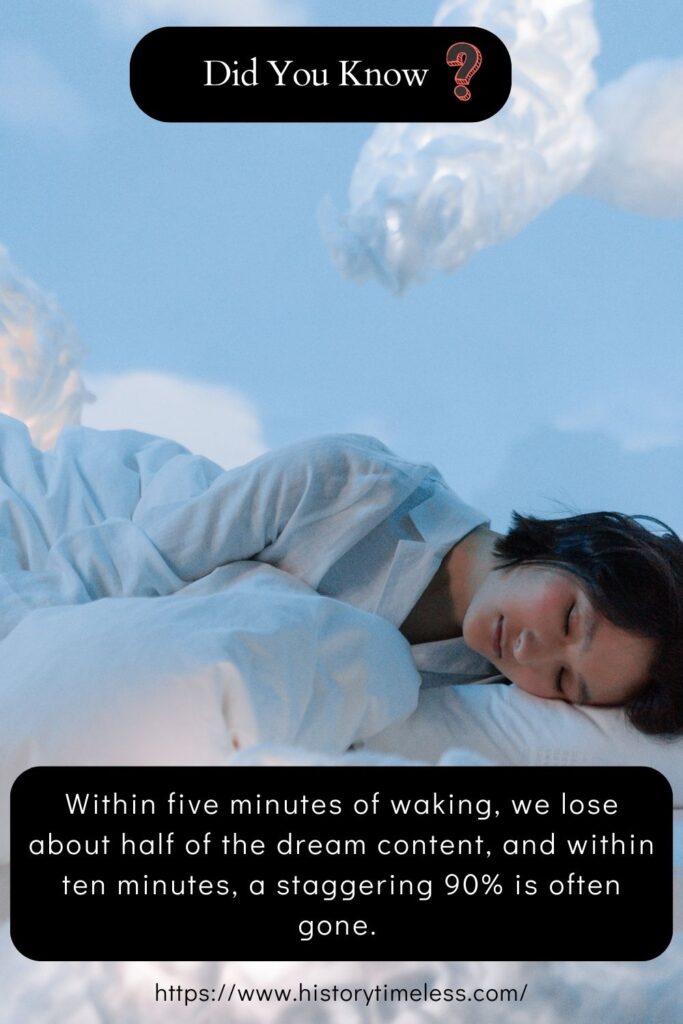Dreams have fascinated humans for centuries, offering glimpses into our subconscious, sparking creativity, and sometimes leaving us puzzled. From bizarre dream experiences to scientific insights, there’s so much to uncover about this mysterious world of sleep.
In this list, we’ll explore 26 intriguing facts about dreams—some surprising, some spooky, and all thought-provoking!
1. We Primarily Dream During REM Sleep Stage of Sleep Cycle
Dreams are most vivid and memorable during the Rapid Eye Movement (REM) stage of sleep. This phase is characterized by brain activity that closely resembles wakefulness, rapid eye movements, increased heart rate, and faster breathing.
While dreams can occur in other sleep stages, REM sleep provides the optimal neurological environment for the rich, narrative-like dreams we often recall.
This stage is crucial for cognitive functions and emotional processing, making dreams during REM a window into our subconscious.
2. You Often Forget 90% of Your Dreams Moments After Waking Up
Dream amnesia is a common phenomenon where a large portion of dream content is rapidly forgotten upon waking. Within five minutes of waking, we lose about half of the dream content, and within ten minutes, a staggering 90% is often gone.

This rapid forgetting is thought to be related to neurochemical changes in the brain during sleep, particularly low levels of norepinephrine and histamine, which are crucial for memory consolidation in the waking state.
3. Dreams Can Be Influenced by Your Waking Life Experiences
Our daily life experiences, emotions, and concerns frequently seep into our dreamscapes. This is known as the “continuity hypothesis” of dreaming.
Stressful events at work, relationship issues, or even a movie you watched before bed can provide the raw material for dream content.
Dreams can be seen as a reflection of our waking thoughts and feelings, often processing and interpreting them in symbolic or metaphorical ways.
4. Not Everyone Dreams in Color – Some Dream in Black and White
While the majority of people report dreaming in color, a significant portion, estimated to be around 12%, claim to dream entirely in black and white.
Interestingly, studies suggest that this percentage was higher in the past, possibly linked to the prevalence of black and white media during earlier generations.
The ability to dream in color or black and white might be related to individual differences in visual imagery and perception, and further research is ongoing in this area.
5. Blind People Still Dream, But Their Dreams Are Different
People who are blind from birth or early childhood still experience dreams, but their dream content differs significantly from sighted individuals.
Instead of primarily visual dreams, blind people’s dreams are often richer in sensory experiences like sounds, smells, tastes, and tactile sensations.
Those who lost their sight later in life might still have visual elements in their dreams, reflecting memories of their sighted experiences, gradually shifting to other sensory modalities over time.
6. Dreams Can Help Process Emotions and Trauma
Dreams serve as a vital function in emotional regulation and processing. During REM sleep, the brain’s amygdala, the emotion center, is highly active, while the rational prefrontal cortex is less so.
This allows for emotional experiences, particularly negative ones, to be replayed and processed in a safe, less emotionally charged environment.
This function is especially crucial for coping with trauma and stressful life events, as dreams can help integrate and make sense of difficult emotions.
7. Lucid Dreaming Allows You to Control Your Dream World
Lucid dreaming is the fascinating phenomenon of being aware that you are dreaming while still in the dream state. This awareness allows you to exert a degree of control over the dream’s narrative, environment, and even your actions within the dream.
Lucid dreaming can be learned and practiced through various techniques, and it opens up exciting possibilities for exploration, problem-solving, and even therapeutic applications, such as overcoming nightmares.
8. Recurring Dreams Often Point to Unresolved Issues
Experiencing the same dream scenario repeatedly is a common phenomenon known as recurring dreams. These dreams often feature similar themes, settings, and emotional tones, and they can persist for weeks, months, or even years.
Psychologists suggest that recurring dreams often signal unresolved conflicts, anxieties, or life challenges that your subconscious is trying to bring to your conscious attention for resolution.
9. Dream Incubation: You Can Influence Your Dreams Before Sleep
Dream incubation is a technique that involves consciously suggesting a specific topic, question, or problem to your subconscious mind before falling asleep, with the intention of influencing the content of your dreams.
This can be done through focused intention, visualization, or even writing down your desired dream topic. While not always guaranteed, dream incubation can increase the likelihood of having dreams related to your chosen theme, potentially offering creative insights or solutions.
10. Nightmares Are More Common Than You Might Think
Nightmares, vivid and disturbing dreams that evoke strong negative emotions like fear, anxiety, or terror, are a surprisingly common experience. While occasional nightmares are normal, frequent or severe nightmares can be distressing and impact sleep quality.
They are often triggered by stress, trauma, anxiety disorders, certain medications, or even spicy late-night meals. Understanding the potential triggers and seeking support if nightmares become persistent is important for well-being.
11. Dreams Can Be Symbolic and Metaphorical Representations
Dreams often communicate through symbolism and metaphors rather than literal representations. A dream about being chased might symbolize feeling overwhelmed by responsibilities, while a dream of flying could represent a desire for freedom or escape.
Dream interpretation involves deciphering these symbolic languages to understand the underlying messages and emotions your subconscious is trying to convey.
12. Animals Also Experience Different Stages of Sleep and Likely Dream
Research across various animal species, including mammals and birds, indicates that they also exhibit different sleep stages, including REM sleep, similar to humans. Observing animals during sleep, particularly their twitching paws or rapid eye movements under closed eyelids, suggests they likely experience dream-like states.
While we can’t know the subjective content of animal dreams, it’s highly probable they also engage in some form of mental activity during sleep.
13. Sleep Paralysis Can Be a Terrifying Bridge Between Sleep and Wakefulness
Sleep paralysis is a frightening experience where you become temporarily unable to move or speak while falling asleep or waking up. It often occurs during the transition between sleep stages, particularly REM sleep. During these episodes, you may be aware of your surroundings but feel paralyzed, sometimes accompanied by vivid hallucinations or a sense of dread. Sleep paralysis is linked to disruptions in the sleep-wake cycle and can be exacerbated by stress or irregular sleep schedules.
14. Déjà vu May Be Linked to Dream Memories
Déjà vu, the strange sensation of having already experienced a present situation, might be connected to dream memories. One theory suggests that déjà vu occurs when a current experience triggers a faint, fragmented memory of a similar dream, creating a feeling of familiarity.
While the exact neurological mechanisms are still debated, the overlap in brain regions involved in memory and dreaming makes this a plausible explanation.
15. Dreams Can Offer Creative Insights and Problem-Solving Solutions
Throughout history, many artists, scientists, and inventors have attributed breakthroughs and creative ideas to insights gained from their dreams.

The less constrained and associative nature of dream thought can allow for novel connections and perspectives that might be missed in waking consciousness.
Dreams can serve as a fertile ground for inspiration and problem-solving, encouraging us to pay attention to the often-unconventional wisdom they offer.
16. Dream Length Varies, But Most Are Relatively Short
While dreams can feel long and elaborate, most individual dreams are relatively short, typically lasting from a few minutes to around 20-30 minutes.
We cycle through several REM sleep periods throughout the night, with the later REM periods tending to be longer and associated with more vivid and complex dreams. The perception of dream duration can be distorted due to the altered sense of time in the dream state.
17. External Stimuli Can Be Incorporated Into Your Dreams
Sensory information from your environment can be incorporated into your dream content. A ringing alarm clock might become the sound of a fire alarm in your dream, or a physical sensation like being cold could manifest as dreaming of being in a snowy landscape.
This “dream incorporation” demonstrates the brain’s ongoing processing of external stimuli even during sleep and its integration into the dream narrative.
18. You Can Have False Awakening Dreams, Thinking You’ve Woken Up
False awakening dreams are a unique type of dream where you dream that you have woken up from sleep, often performing your morning routine within the dream.
These dreams can be incredibly realistic and convincing, sometimes involving multiple layers of false awakenings before you actually wake up in reality. They highlight the brain’s ability to create highly detailed and believable simulations of waking life in the dream state.
19. Dreams Can Predict the Future – Or Is It Just Coincidence?
The idea that dreams can predict the future, known as precognitive dreams, has been a long-standing belief across cultures.
While anecdotal accounts exist, scientific evidence supporting precognitive dreams is lacking and often attributed to coincidence, confirmation bias, or vague dream interpretations that can be retroactively fitted to events.
However, the subjective experience of feeling like a dream foreshadowed a real event can be powerful and intriguing.
20. Dream Interpretation Has a Long and Varied History
The practice of dream interpretation dates back to ancient civilizations, with cultures like the Egyptians, Greeks, and Romans valuing dreams as messages from the gods or glimpses into the future.
Throughout history, various dream theories and interpretation methods have emerged, from Freudian psychoanalysis to Jungian archetypal symbolism, reflecting diverse cultural and psychological perspectives on the meaning and significance of dreams.
21. Cultural Background Shapes Dream Content and Interpretation
Cultural background significantly influences both the content of our dreams and how we interpret them. Cultural beliefs, values, and symbols are often reflected in dream themes and imagery.
Different cultures may have varying views on the purpose and meaning of dreams, ranging from spiritual communication to psychological processing, shaping how dreams are understood and integrated into waking life.
22. Dream Research is an Ongoing and Evolving Field
Dream research is a dynamic and interdisciplinary field encompassing neuroscience, psychology, and philosophy. Scientists are continuously exploring the neural mechanisms of dreaming, its functions, and its relationship to consciousness, memory, and emotion.
Technological advancements like brain imaging techniques are providing new insights into the complexities of the sleeping and dreaming brain, pushing the boundaries of our understanding.
23. Food and Diet Can Influence Your Dreams
What you eat, especially before bed, can affect your dreams. Certain foods, particularly spicy foods or heavy meals consumed close to bedtime, have been reported to increase the likelihood of vivid or disturbing dreams, potentially due to changes in body temperature, digestion, or sleep patterns. While more research is needed, anecdotal evidence suggests a link between diet and dream experiences.
24. Stress and Anxiety Can Intensify Dream Activity
Stress and anxiety are significant factors that can intensify dream activity and influence dream content. Periods of high stress often lead to more frequent and vivid dreams, including nightmares or anxiety dreams.
Dreams can reflect and process waking anxieties, sometimes in exaggerated or symbolic ways. Managing stress and promoting relaxation techniques can contribute to more peaceful and less disturbed dream experiences.
25. Music and Sounds Can Appear in Your Dreamscapes
Just as external sounds can be incorporated into dreams, so too can music and other auditory experiences. You might dream of hearing a familiar song, or even create original melodies within your dream world.
Music in dreams can evoke strong emotions and contribute to the overall atmosphere and narrative of the dream, reflecting your musical preferences and emotional associations.
26. Sharing and Discussing Dreams Can Be Beneficial
Sharing and discussing your dreams with others can be a valuable practice. Talking about your dreams can help you process and understand their potential meanings, gain different perspectives, and enhance dream recall.
Dream sharing can also be a source of creative inspiration, personal insight, and even strengthen interpersonal connections through shared experiences of the fascinating world of dreams.
Enjoy these eye-opening discoveries:
28 Fascinating Facts About China You Won’t Believe!
26 Facts About Cancerian Only True Cancers Will Get!
20+ Insane Facts About Animals That Defy Belief!
15+ Interesting World Facts: Say ‘Wow’ to These Discoveries!





